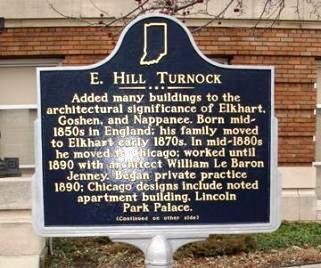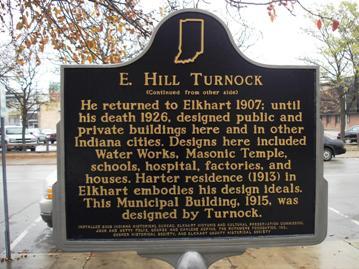E Hill Turnock


Location: Elkhart Municipal Building, 229 S. Second Street, Elkhart. (Elkhart County, Indiana)
Installed: 2006 Indiana Historical Bureau, Elkhart County Historical Society, Elkhart Historic and Cultural Preservation Commission, Jack and Betty Foltz, George and Darlene Adkins, The Ruthmere Foundation, Inc., and Goshen Historical Society.
ID# : 20.2006.2
Text
Side one:
Added many buildings to the architectural significance of Elkhart, Goshen, and Nappanee. Born mid-1850s in England; his family moved to Elkhart early 1870s. In mid-1880s he moved to Chicago; worked until 1890 with architect William Le Baron Jenney. Began private practice 1890; Chicago designs include noted apartment building, Lincoln Park Palace.
Side two:
He returned to Elkhart 1907; until his death 1926, designed public and private buildings here and in other Indiana cities. Designs here included Water Works, Masonic Temple, schools, hospital, factories, and houses. Harter residence (1913) in Elkhart embodies his design ideals. This Municipal Building, 1915, was designed by Turnock. "
Keywords
Buildings and Architecture
Annotated Text
Side one:
Added many buildings to the architectural significance of Elkhart, Goshen, and Nappanee.(2) Born mid-1850s in England;(3) his family moved to Elkhart early 1870s.(4) In mid-1880s he moved to Chicago; worked until 1890 with architect William Le Baron Jenney.(5) Began private practice 1890;(6) Chicago designs include noted apartment building, Lincoln Park Palace.(7)
Side two:
He returned to Elkhart 1907;(8) until his death 1926, designed public and private buildings here and in other Indiana cities.(9) Designs here included Water Works, Masonic Temple, schools, hospital, factories, and houses.(10) Harter residence (1913) in Elkhart embodies his design ideals.(11) This Municipal Building, 1915, was designed by Turnock.(12)
Notes:
(1)There is some disagreement in sources about his first name. In various sources Turnock's first name is spelled "Enos, " (Weaver); Enoch (New York Passenger Lists); or "Enock" (Rieb). "E." is used in his obituary, in newspaper advertisements, and entries in city directories. Abraham E. Weaver, A Standard history of Elkhart County, Indiana (Chicago, 1916), 899-901 (B00015); New York Passenger Lists, 1851-1891, microfilm, roll 339, list no. 142, http://search.ancestrylibrary.com (accessed July 7, 2005);(B00134) George E. Riebs, Elkhart, a Pictorial History (St. Louis, c1990), 128-129;(B00617) "E. Hill Turnock Dies at Age of 70, " Elkhart Truth, July 8, 1926, p.1;(B00620) Directory of Elkhart and Elkhart County Gazetteer (1908), 315.(B0062)
(2)For a list with brief descriptions of many of the buildings Turnock designed in Elkhart, see, "Discovering Turnock: A Slide Presentation on Architect E. Hill Turnock, " June 20, 1997, Robert B. Beardsley Arts and Reference Library, Ruthmere Museum, Elkhart.(B00017) Pages 1, 6, and 8 include descriptions of Turnock's three distinct design periods. "Discovering Turnock, " was a long-term project to identify buildings designed by Turnock as well as to develop biographical information. The collection resides at the Ruthemere Museum, Robert B. Beardsley Arts and Reference Library, Elkhart, Indiana.
(3)The year of E. Turnock's birth has not be confirmed. Based on his obituary, Turnock would have been born sometime between July 27, 1855 and July 26, 1856. "E. Hill Turnock Dies, " Elkhart Truth, July 8, 1926.(B00020) According to the New York passenger lists that recorded his entry into the United States, Turnock's "Estimated Birth Year" was 1857. New York Passenger Lists.(B00134) Meanwhile, Abraham Weaver states that "Enos Hill Turnock" was born February 27, 1857. Weaver, Standard History, 900.(B00015)
(4)According to Weaver, and a 1920 article in the Elkhart Truth, the Turnocks came to Elkhart in 1872. Abraham E. Weaver, Standard History, 900 (B00015); "Who's Who in Elkhart, " Elkhart Truth, January 14, 1920.(B00019) However, according to the New York Passenger Lists, the Turnocks arrived in New York on February 23, 1871. Then on March 20, 1871, a "Richard Turnock" (age 23 and probably E. Hill's brother) filed a Declaration of Intention in the Elkhart Count Circuit Court on March 20, 1871. Alan January, State Archives, to IHB, email, July 18, 2005.(B00131) It is not clear if E. Hill and the rest of the family arrived with Richard or if they came in 1872.
(5)"Personal, " Inland Architect and News Record, July 1890, 91;(B00618) "Buildings: The W. I. Clark House, La Grange, Illinois, " Frank Lloyd Wright Newsletter 1, no. 3 (May-June 1978), 4, 8.(B00619) Also see, Timothy Wittman (Commission on Chicago Landmarks) to Scott LaFrance (Chicago Historical Society), memo, October 17, 1990.(B00620)
For more on architect William Le Baron Jenney, see the Chicago Landmarks Web site, http://www.ci.chi.il.us/Landmarks/Architects/Jenney.html. (B00076)
(6)"Personal, " Inland Architect, 91.(B00618) Turnock listed in 1890 Lakeside Business Directory.(B00621) "Buildings, the W. I. Clark House, " 8.(B00619)
7)The Lincoln Park Palace apartment building is now called the Brewster Apartments, at 500 West Diversey, Chicago. Listed as a Chicago Landmark, this was an early example of skeleton-frame construction of a residential building; includes atrium, cast iron bridges, and glass block hall floorways. Discovering Turnock, 2.(B00017); Chicago Landmarks at
In the index to the database of Chicago building permits from 1898-1912, Turnock is listed as the sole architect on 37 buildings; dating from 1898 to 1907. Turnock and Ohrenstein are listed as the architect on 40 additional buildings from 1902 to 1905. "Index to the American Contractor's Chicago Building Permit Column, 1898-1912, " database, Chicago Historical Society Web site, http://www.chsmedia.org/househistory/1898-1912 permits/search.asp (accessed April 9, 2005) (B00018).
Credited with designing Broadway United Methodist Church. See www.brdwyumc.org/history.php (accessed March 12, 2005).(B00083)
He designed a hotel in Decorah, Iowa. "The New Winneshiek, " Decorah (Iowa) Republican, April 27, 1905;(B00063) "New Winneshiek, " Decorah (Iowa) Republican, May 4, 1905.(B00073) Designed 3-story apartment building for a Mr. Cooper. Inland Architect and News Record, February 1895.(B00680)
As part of Turnock and Ohrenstein, designed the Talmud Torah School and the Hoffman apartment building in Chicago. The Inland Architect and News Record, February 1905;(B00627) The Inland Architect and News Record, September 1905, p. 21.(B00628)
8) "Who' s Who" and Weaver report that Turnock returned to Elkhart in 1907. "Who's Who in Elkhart, " Elkhart Truth, January 14, 1920;(B00019) Weaver, Standard History, 900.(B00015) According to the index of Chicago building permits, the latest entry for a Turnock building in Chicago is in March 1907. "Index to the American Contractor's."(B00018) In May 1907, an advertisement for Turnock appears in an Elkhart newspaper, listing Elkhart address. Elkhart Daily Review, May 6, 1907.(B00629)
(9)Elkhart Daily Review, May 6, 1907;(B00629) "Who's Who, " Elkhart Truth;(B00019) Indiana Historic Sites and Structures Inventory Interim Report, Elkhart County, Indianapolis: HLFI & DHPA, IDNR, 1978, pp. 30-41;(B00079) "Discovering Turnock" (B00017); Tom Stephenson, "Ode of Praise to E. Hill Turnock, " Elkhart Truth, July 22, 1972.(B00082)
Five Turnock-designed buildings are listed in the National Register of Historic Places, in Elkhart and Nappanee, Indiana. National Register of Historic Places Web site, http//:www.nr.nps.gov (accessed October 6, 2005).(B00630)
Other cities where Turnock's designs appear include Goshen, Indiana where he designed the Spohn Building, Masonic Temple, Goshen Hospital, and Goshen High School. Stephenson, "Ode of Praise."(B00082)
(10)"Discovering Turnock"; (B00017) Elkhart County Interim Report, 30-41;(B00079) Stephenson, "Ode of Praise"; The Pennant [Elkhart High School], February, November, December 1910, January 1911, October 1912.(B00623) Copies of The Pennant are located in the collections of the Elkhart Public Library.
Turnock also designed the Blackford County Hospital, 1923. A History of Blackford County, Indiana (Hartford City, Ind., 1986), 31-32.(B00624)
(11)The Harter residence is at 760 Riverside Drive, Elkhart. Turnock emphasized that the architect's design needs to be in harmony with the dwelling's surroundings: "bringing the interior of the home in close communion with nature, " and an architect "must not repeat any of his designs." Turnock also stated, "a home must be built to outlive fads and passing fancies." "The City Beautiful, " by E. Hill Turnock, Elkhart Truth, "Forward Edition, " June 1915. (B00086) The Harter residence was featured in The Western Architect, 19: 4 (April 1913).(B00626)
"The use of art glass, horizontal emphasis, and his trademark red tile roofing" material are significant and unique features of the Harter house. "Discovering Turnock: A Slide Presentation on Architect E. Hill Turnock, " 7. (B00017)
(12)"Elkhart's New Municipal and Superior Court Building, " Elkhart Truth, "Forward Edition, " June 1915, p. 22; (B00087) "Discovering Turnock"; (B00017) "'Made-in-Elkhart' - And We're Proud of It, " Elkhart Daily Review, April 11, 1916. (B00088)
(13)"E. Hill Turnock Dies." (B00020)
Turnock is buried in Lindenwood Cemetery, Fort Wayne, Indiana. Interment Records, Lindenwood Cemetery, Fort Wayne, Indiana, 1860-1972, Vol. 13, abstracted by Fort Wayne Public Library.(B00622)
